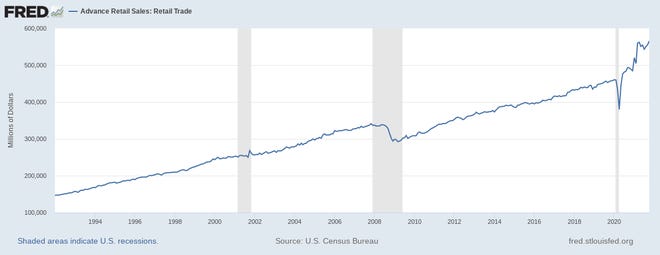
Walmart (NYSE: WMT) just trounced third-quarter estimates.
Despite supply-chain woes, the world’s largest company by revenue posted 9.2% comparable-store sales growth in the U.S., good for a two-year growth rate of 15.6%. Sales at Sam’s Club were even stronger with comps jumping 13.9% or 25% on a two-year basis.
Overall revenue rose 4.3% to $140.5 billion, easily beating estimates of $135.6 million. Excluding businesses that the company divested overseas in the past year, revenue was up 12%. On the bottom line, adjusted earnings per share increased from $1.34 to $1.45, outpacing expectations of $1.40.
The retail giant also raised its guidance for the full year, calling for Walmart U.S. comparable sales growth of 6% and adjusted earnings per share of $6.40 compared to previous guidance of $6.20-$6.35.
The market mostly shrugged off the results with Walmart stock trading nearly flat following the earnings release, but the numbers show the company is unperturbed by the supply-chain crisis. Though management said that supply-chain challenges were the main reason why gross margin fell 42 basis points, Walmart is also in an excellent position heading into the holiday quarter with inventory up 11.5% on a year-over-year basis – and that helps ensure it has sufficient merchandise in stock for the peak shopping season.
Retail sales are booming
Shortly after Walmart turned in its earning report, October retail sales numbers came out from the U.S. Department of Commerce, confirming that the retail sector is still on fire. Retail sales rose 1.7% from September to October after a 0.8% gain a month earlier. On a year-over-year basis, October sales jumped 16.3% and were up by double digits in nearly every category, including those that had performed well last year like groceries and home improvement. On a month-over-month basis, only two retail categories were negative – clothing along with health and personal care – and those fell by less than 1%.
The graph below underscores how strong the retail sector has been in recent months.

Had retail sales continued on the trajectory they were on before the pandemic, monthly sales might have been about $100 billion lower than they are currently. There are a number of reasons for the shopping boom, including making up for lost experiences during the pandemic, several rounds of stimulus and enhanced unemployment support, a boom in asset prices across stocks, housing, and cryptocurrency, and rising inflation and wages. The “Great Resignation” seems to indicate that Americans feel more economically confident than they have in generations, and retailers are reaping the benefits of that largesse.
Buy retailers, not brands
At the same time that retailers are thriving, the brands that supply them – and are responsible for manufacturing and shipping their own merchandise – are struggling. A number of the world’s biggest brands have said that supply-chain challenges are weighing on their bottom lines, including Nike, Whirlpool, General Motors, and Apple. In fact, it’s difficult to find a major consumer brand that isn’t facing some kind of supply-chain-related constraint.
You might think that production delays and shortages would be impacting retailers, but that’s not the case, and it shows a major advantage retailers have here. If one brand is short on supply, retailers can find a different one to substitute for it. If a shopper wants, say, a toy from Hasbro for their kid but it’s out of stock, they’ll just buy a different one. It’s a neutral outcome for the retailer, but a clear negative for manufacturers.
There’s another reason why retailers like Walmart and Home Depot (which also reported strong earnings Tuesday morning) have an advantage: suppliers need to stay in their good graces. Shelf space at a Walmart or a Home Depot is extremely valuable. Walmart accounts for nearly 10% of non-automotive retail spending in the U.S. If you’re a maker of granola, t-shirts, or bicycles, you’re going to want to supply the Walmart account first, because that relationship likely accounts for a substantial portion of your sales. That’s also true for other large retailers like Target, Costco, and others. Independent stores, on the other hand, are likely going to have a tougher time keeping inventory in stock as they’ll be the first retailers to feel the pinch from the supply squeeze.
Heading into the holiday season, there’s one clear way to play the supply-chain crunch. Big retail stocks are poised to thrive even as the brands they count on may suffer.























